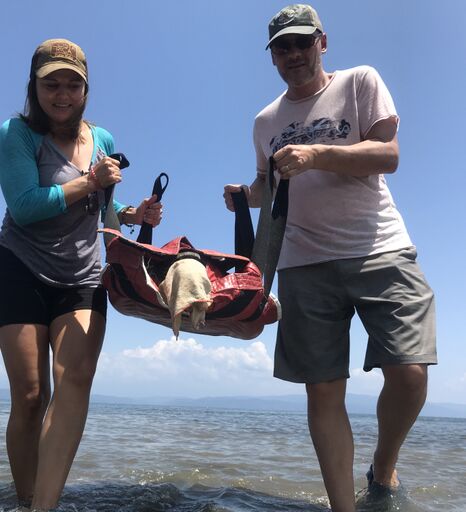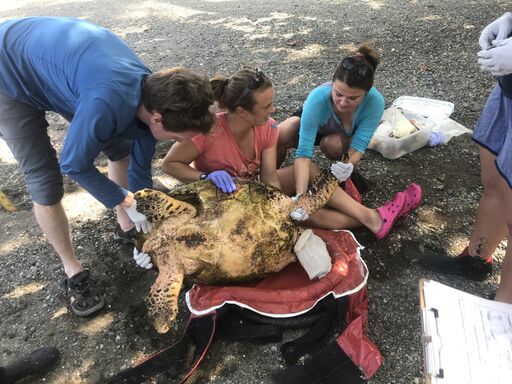The sea turtle has become an endangered species during the last half-century; in Costa Rica, organizations are coming together with a unique message
Sea turtles in Costa Rica face many threats and travelers can help bring them back from the edge of extinction. Worldwide, 6 of the 7 species are considered vulnerable or endangered. Reasons for the decline include predation (human and environmental), climate change, tourism impact, and oceanic pollution. Solutions can be long term and difficult to achieve; but, the human impact on sea turtles resulting from beach lighting, poaching for eggs, meat and shells, coastal development, and pesky human intrusion by unregulated tourism, sightseeing, fishing, or littering can be readily addressed through education.

Costa Rica’s Osa Peninsula provides prime sea turtle nesting beaches like this one.
The goal of non-profit SEE Turtle’s campaign Too Rare to Wear is to spread a less obvious message with global importance. Tourists can make their own contribution to turtle conservation by not buying or using products made from turtle shells, making a statement on turtle poaching, and spreading the word about the serious impact that those pretty trinkets can have on these beautiful animals, and in turn, our oceans.
The Too Rare to Wear website offers tips on how to spot endangered turtle shell and tell it apart from plastic, coconut shell or bull horn, and gives suggestions about reducing the impact by simply refusing to buy such items from souvenir vendors or even reporting them to local authorities via the link and form on their site.
Sea turtles and their eggs have traditionally been a source of income for Costa Ricans through the sale of turtle products. Sadly, tortoiseshell jewelry, which is sold widely throughout the country, comes from the hawksbill sea turtle. Less commonly, but still happening, is the sale of turtle eggs, which is considered by some to be a delicacy.
Through a program of education and conservation initiatives, those same Costa Ricans are educated about the endangerment of the sea turtles, along with the importance of safeguarding them, and are employed as guides and monitors during nesting season.
In keeping with its focus on sustainable ecotourism, GreenSpot Travel has partnered with SEE Turtles to give clients an opportunity to participate and support sea turtle conservation efforts. SEE Turtles co-founder, environmental economist, and author Brad Nahill says, “SEE Turtles supports important community-based sea turtle conservation organizations to protect important nesting beaches, educate travelers and the general public about protecting these animals, and ending the demand for turtle shell products.”
SEE Turtles co-founder, Brad Nahill (L) and GreenSpot.travel co-founder, Irene Edwards (R) work with local staff on Costa Rica’s Osa Peninsula to protect endangered sea turtles.
According to Nahill, until the 1990s Japan imported approximately 2 million turtle shells over a 50-year span. Hawksbill sea turtles were heavily impacted: approximately 15,000 adult females are left to support the species’ survival. Fewer females mean fewer eggs, and even fewer hatchlings surviving to adulthood.
Of the endangered animals in Costa Rica, Nahill says, “Sea turtles in Costa Rica face a number of threats, including the use of their eggs, meat, and shells, plastic pollution, and getting caught in fishing gear. But thanks to the work of many local organizations, working in partnership with the tourism industry, they are recovering in several places around the country.”
The partnership is based on GreenSpot co-founder and award-winning sustainable tourism specialist Irene Edwards’ belief that carefully managed tourism and conservation are not mutually exclusive propositions in Costa Rica. In fact, ecotourism is proving to be a viable economic alternative to harvesting sea turtles. Likewise, it has significantly lightened the impact of tourism on nesting sites.
Edwards spent time as recently as last week working on a turtle conservation project in the Osa Peninsula of Costa Rica, where she lent a hand with three hawksbill turtles alongside Nahill. During her visit, she learned more about the critical part the endangered hawksbill plays in the health of our ocean coral reef systems. Coming away from the experience, Edwards said, “Getting close and personal with these creatures teaches you how sensitive and gentle they are. It was fascinating to learn how their shell is a living ecosystem and home to so many organisms. If we protect the sea turtles, we protect other species and our oceans.”

Research requires short transportation of turtles to shade to collect vital information. GreenSpot’s Irene Edwards uses some muscle to help researchers.
Low impact, beneficial interaction and a focus on sustainable, meaningful tourism is something that GreenSpot is uniquely positioned to promote, a distinction made even more profound through their new partnership with SEE Turtles.
While it’s only natural to want to experience the sight of females pulling themselves up the beach to nest, the presence of people can deter them from digging out a hole and laying their eggs. SEE Turtles gives helpful guidelines for turtle watching and general conservation, such as:
- ALWAYS use a certified guide for visits to turtle nesting sites.
- Follow your guide’s instructions to help minimize your impact during this critical period.
- Avoid taking flash photos.
- Refrain from touching the turtles; in fact, it’s best to keep your distance.
- Don’t make sudden moves or loud noises.
- Reduce or eliminate your use of plastic.
For lasting memories during your Costa Rica travel, focus on how you feel about your experience of seeing the turtles in their natural environment. At the end of the day, you’ll be happier with yourself about not disrupting the turtles’ natural rhythms than you would be if you’d poked a selfie stick into their space. Want to share your experience? Do it with words instead of photo images and leave the photo taking to trained professionals with the right, non-intrusive equipment.
For more information about a trip to Costa Rica to see the turtles nesting or even a conservation trip to volunteer, contact us today; we’re standing by to assist you with your customized ecoluxe vacation.

